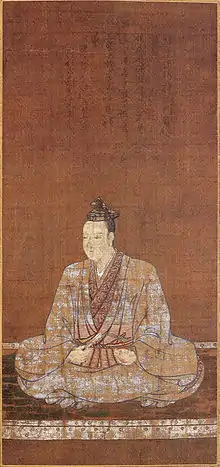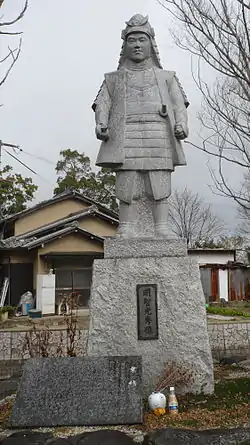Akechi Mitsuhide
Akechi Mitsuhide (明智 光秀, 10 March 1528 – 2 July 1582),[1] first called Jūbei from his clan and later Koretō Hyūga no Kami (惟任日向守) from his title, was a Japanese samurai general of the Sengoku period best known as the assassin of Oda Nobunaga.
Akechi Mitsuhide 明智 光秀 | |||||
|---|---|---|---|---|---|
 An Edo period painting of Akechi Mitsuhide. | |||||
| Nickname(s) | Jūbei (十兵衛) Koretō Hyūga no Kami (惟任日向守) | ||||
| Born | March 10, 1528 Mino Province, Japan | ||||
| Died | July 2, 1582 (aged 54) Settsu Province, Japan | ||||
| Allegiance | |||||
| Unit | |||||
| Battles/wars | Battle of Nagara-gawa Siege of Mount Hiei Ishiyama Hongan-ji War Siege of Kuroi Battle of Tedorigawa Siege of Yakami Honnō-ji Incident Battle of Yamazaki | ||||
| Spouse(s) | Tsumaki Hiroko | ||||
| Children | Akechi Mitsuyoshi Akechi Tama at least one other daughter | ||||
| Relations | Akechi Hidemitsu (son-in-law) Akechi Mitsuharu (cousin) | ||||
| Japanese name | |||||
| Kanji | 明智 光秀 | ||||
| Hiragana | あけち みつひで | ||||
| |||||
Mitsuhide was a bodyguard of Ashikaga Yoshiaki and later a successful general under daimyō Nobunaga during his war of political unification in Japan. Mitsuhide rebelled against Nobunaga for unknown reasons in the Honnō-ji Incident in 1582, forcing the unprotected Nobunaga to commit seppuku in Kyoto.
Mitsuhide attempted to establish himself as shōgun, but was pursued by Nobunaga's successor Toyotomi Hideyoshi and defeated at the Battle of Yamazaki. Mitsuhide's reign as shōgun only lasted 13 days, hence the reference "thirteen-day shogun", The short reign of Mitsuhide is listed as the inspiration for the yojijukugo set phrase mikkatenka (三日天下, short-lived[2] reign).[3][4]
He is still popular in present culture. A ceremonial activity was held on April 15, 2018 in Kyoto.[5]
Early life and rise

Akechi Mitsuhide was born on 10 March 1528 in Tara Castle, Mino Province (present-day Kani, Gifu Prefecture)[6] Mitsuhide was a descendant of the Toki-Akechi family of the shugo Toki clan. Mitsuhide is rumored to be a childhood friend or cousin of Nōhime. It is believed that he was raised to be a general among 10,000 by Saitō Dōsan and the Toki clan during their governorship of the Mino Province. When Dōsan's son, Saitō Yoshitatsu, rebelled against his father in 1556, Mitsuhide sided with Dōsan.
Service under Ashikaga shogunate and Oda clan
Mitsuhide began serving the "wandering shōgun" Ashikaga Yoshiaki as one of his guardians under Hosokawa Yusai. Shōgun Ashikaga ordered Asakura Yoshikage to be his official protector, an offer which Yoshikage declined. Yoshiaki appealed to Mitsuhide, who suggested Oda Nobunaga instead.[7]
In 1564, Nobunaga sent his younger sister Oichi to become Azai Nagamasa's bride. This helped him in the 1566 conquest of Mino province, and paved the way through Omi province to Kyoto. In November 1568, Nobunaga, Yoshiaki and Mitsuhide arrived in Kyoto, the capital of Japan, and Nobunaga made Yoshiaki the next shogun and turned Hongoku-ji temple into a temporary palace. However, after Nobunaga and his followers returned from Kyoto on January 4, 1569, the Miyoshi clan attacked Ashikaga Yoshiaki at Hongoku-ji, but Mitsuhide managed to defend the shōgun and repulsed the Miyoshi clan. Then Nobunaga asked Mitsuhide to join his army and Mitsuhide decided to service under the shōgun and Nobunaga.
Mitsuhide received Sakamoto and built Sakamoto Castle in 1571 after the successful attack at the Enryaku-ji temple.[8] Although Nobunaga rarely put too much trust in his retainers, he particularly trusted Shibata Katsuie, Hashiba Hideyoshi, and Akechi Mitsuhide, who was the first subordinate to receive a castle from Nobunaga. After Mitsuhide received Sakamoto, he moved to pacify the Tanba region by defeating several clans such as the Hatano clan and Akai Naomasa of Tango. Mitsuhide also received Kameyama castle and Tanba Province (550,000 koku). He participated in Ishiyama Hongan-ji War (1570-1580) and the Battle of Tedorigawa in 1577.[1]:27,228
Honnō-ji Incident
In 1579, Nobunaga captured Yakami Castle from Hatano Hideharu by promising Hideharu peace terms; however, Nobunaga betrayed the peace agreement and had Hideharu executed. This reputedly displeased the Hatano family. As a result of this, several of Hideharu's retainers murdered Akechi Mitsuhide's mother (or aunt).[1]:230 The failing relationship between Nobunaga and Mitsuhide was further fueled through several public insults which Nobunaga directed at Mitsuhide.
In 1582, Mitsuhide was ordered to march west and assist Hashiba Hideyoshi who was at that time fighting the Mōri clan. Ignoring his orders, Mitsuhide assembled an army of 13,000 soldiers and moved against Nobunaga's position at Honnō-ji. On June 21, Mitsuhide was quoted as saying, "The enemy is at Honnō-ji!" His army surrounded the temple and eventually set it on fire. Oda Nobunaga was killed either during the fighting, or by his own hand. Nobunaga's son, Oda Nobutada, fled the scene, but was surrounded at Nijō and killed.[9] Despite not killing Nobunaga personally, Mitsuhide claimed responsibility for his death.
Mitsuhide's betrayal of the Oda shocked the capital, and he was forced to move quickly to secure his position. Mitsuhide looted Azuchi castle to reward his men and maintain their loyalty.
Mitsuhide attempted to make gestures of friendship to a panicked Imperial Court; he also made many attempts to win over the other clans, but to no avail. Hosokawa Fujitaka, to whom he was related through marriage, quickly cut ties with him.
Tsutsui Junkei half-heartedly supported Hideyoshi.[1]:278
Death
Mitsuhide had counted on Toyotomi Hideyoshi being occupied fighting with the Mori, and unable to respond to Mitsuhide's coup d'état. However, having learned of the assassination of his lord, Hideyoshi quickly signed a peace treaty with the Mori, and alongside Tokugawa Ieyasu rushed to be the first to avenge Nobunaga and take his place.
Hideyoshi force-marched his army to Settsu in four days, and caught Mitsuhide off guard. Mitsuhide had been unable to garner support for his cause, and his army had dwindled down to 10,000 men. Hideyoshi, however, had won over former Oda retainers, including Niwa Nagahide and Takayama Ukon, and had a strength of 20,000 men. The two forces met at the Battle of Yamazaki.
Battle of Yamazaki
Mitsuhide took up a position south of Shōryūji Castle, securing his right flank by the Yodo river, and his left at the foot of the 270-metre Tennozan. Hideyoshi immediately seized the advantage by securing the heights of Tennōzan; his vanguard then maneuvered to face the Akechi forces along the Enmyōji river. Mitsuhide's forces made a failed attempt to force Hideyoshi from Tennōzan. Hideyoshi's general, Ikeda Nobuteru moved to reinforce Hideyoshi's right flank, which soon crossed Enmyōji-gawa and turned the Akechi flank. Simultaneously, Hideyoshi's forces marched against the Akechi front; this started a rout, only two hours after the battle had begun.[10] Mitsuhide's men fled, with the exception of the 200 men under Mimaki Kaneaki, who charged and were destroyed by Hideyoshi's larger force. Soon, panic set in among the Akechi army, and Hideyoshi's army chased them back to Shōryūji, where the garrison collapsed. Akechi was later killed while fleeing the battle of Yamazaki by the bandit leader Nakamura Chōbei.[1]:277–278
Reasons for betrayal
No one knows the specific reason that Mitsuhide betrayed Nobunaga, though there are several theories:
- Personal ambition - Mitsuhide had grown tired of waiting for promotion under Nobunaga or had grown tired of being under another's authority.
- A personal grudge:
- During the battle at Yakami Castle, 1575, Mitsuhide's mother died for Nobunaga's cause.
- Nobunaga accused Mitsuhide of superficially praising his allies after their victory over the Takeda and physically kicked him.
- While staying at Azuchi Castle, Tokugawa Ieyasu complained about the food he was served. Nobunaga responded by throwing Mitsuhide's priceless dinnerware into the garden pond.
- Nobunaga had asked him to – a legend states that Nobunaga asked Mitsuhide to strike him down if he were ever to become too ruthless, and the Incident at Honnō-ji is Mitsuhide fulfilling this promise.
- Betrayal by Hosokawa Fujitaka – Fujitaka, father of Mitsuhide's son-in-law, was said to have promised aid to Mitsuhide but in actuality was reporting the plot to Hideyoshi.
- He was asked to – one theory is that he was asked or influenced to betray Nobunaga by Mōri Terumoto, Tokugawa Ieyasu, Toyotomi Hideyoshi, Ashikaga Yoshiaki, Nōhime, Esam Abunaga, the Shimazu clan or Emperor Ogimachi.
- Protecting the Imperial Court. One theory supposed Nobunaga may have abolished the Imperial Court in Kyoto, when he no longer needed it. Akechi Mitsuhide, who was, before his treason, seen as an honorable samurai, and had been a retainer to both Nobunaga and the Ashikaga shogunate, asked his lord to guarantee the safety and honorific position of the Court, or at least for the Emperor.

| Wikimedia Commons has media related to Akechi Mitsuhide. |
Family
- Tsumaki Hiroko (Ja:妻木煕子): Wife
- Akechi Mitsuyoshi (明智光慶): Eldest son
- Akechi Hidemitsu (明智秀満): Adopted son (and son-in-law); ancestor of Sakamoto Ryōma
- Hosokawa Gracia (明智玉子): Daughter, wife of Hosokawa Tadaoki; ancestor of Empress Shōken
- Akechi Mitsuharu (明智光春): Cousin
Tensho Koshirae sword
The sword of Mitsuhide is of the Tensho style; the 'Tensho Koshirae' was first designed to be a replica of Akechi Mitsuhide's own sword. The Akechi family was able to trace their heritage to the Toki clan and from there to the Minamoto clan.
Castles built or reconstructed by Mitsuhide
Mitsuhide was well known as a master of castle construction, and was engaged in the construction of many castles.[11][12]
- Sakamoto Castle , Main base of Akechi clan.(Mitsuhide`s residence)
- Fukuchiyama Castle
- Kameyama Castle, In 2019, Akechi Mistuhide`s statue was built in the castle.[13]
- Shūzan Castle
- Kinzan Castle
- Kuroi Castle
- Shūchi Castle
- Usayama Castle
References
- Turnbull, Stephen (1998). The Samurai Sourcebook. Cassell & Co. p. 212. ISBN 1854095234.
- According to the Sanseido reference, 三日 should be understood not literally as three days, but as "ごく短い期間", e.g. an exceptionally short period of time
- "三日天下" [Mikkatenka]. 広辞苑第六版 (Koujien, 6th edition) (in Japanese). 株式会社岩波書店 (Iwanami Shoten, Inc.). 2008.
- 三日天下 [Mikkatenka]. 新明解四字熟語時点 (Shinmeika Yojijukugo Jiten) (in Japanese). 三省堂(Sanseidō). Retrieved 5 Sep 2013.
- http://www.kyoto-np.co.jp/sightseeing/article/20180411000093
- Miyagi keizu and Kitamra kaden
- "Akechi Mitsuhide". www.samurai-archives.com.
- "坂本城" (in Japanese). 滋賀県観光情報. Retrieved 25 July 2019.
- "Oda Nobunaga". www.samurai-archives.com.
- "Toyotomi Hideyoshi". www.samurai-archives.com.
- "【明智光秀の城】坂本城と亀山城の歴史を紐解く!" (in Japanese). 歴史マガジン. Retrieved 25 July 2019.
- "明智光秀とは?" (in Japanese). 岐阜県大河ドラマ「麒麟がくる」推進協議会. Retrieved 25 July 2019.
- "明智光秀の功績しのび、銅像の除幕式 京都・亀岡でまつり" (in Japanese). 京都新聞. Retrieved 25 July 2019.